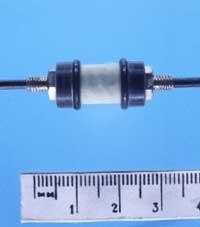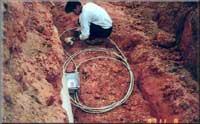Improvement of fiber optic sensors
The thesis presented by Silvia Abad Valtier at the Public University of Navarra presents a technique of cheapening and improving fiber optic sensors through shared networks. The same engineer has won the Epson Ibérica award for this work.

Silvia Abad's final project focused on multiplexing fiber optic sensors and continued to study the same topic at the same university. During the three years of his thesis he has visited other centers, mainly the United States and Portugal. In particular, since August, he has worked at Multiwave Networks Portugal in Porto (Portugal) in the research and development of advanced optical communications components and systems.
Advantages of fiber optic sensor
A sensor is a tool to measure a certain parameter, such as temperature or humidity. In short, the fiber optic sensor is a tool that uses fiber optic components instead of electronic for measurement.
The characteristics that characterize both sensors (fiber optics and electronics) have to do with their size and weight; fiber optics are smaller and lighter. In addition, fiber optic devices do not suffer electromagnetic interference.

Precisely for these reasons, the fiber optic sensor has more advantages than the electronic one. Fiber optic sensors can and are used in civil engineering. They are introduced into bridges and dams and provide measurement parameters of the internal structure. In addition, these types of sensors are very useful for hazardous areas such as pipelines, pipelines, nuclear power plants or power plants. In these areas, the use of electronic sensors can cause major problems due to the risk of sparks. Therefore, fiber optic sensors are placed, as these devices do not use any electrical system in the device itself and control and processing electronics are away from the sensor.
Share the most expensive part of the process
Fiber optic sensors are more expensive than electric sensors, so a network of sensors is investigating how to join the information of all these devices in one space. The truth is that the sensor is not expensive, but elements associated with it: light sources, detectors and all control electronics. Therefore, Silvia Abad's research seeks multiplexing, that is, how to distribute this side of the process so that the use of many fiber optic sensors is more economical.

In fact, Silvia Abad believes that although in the last decade fiber optic sensors have had a great development, it has prevented its costs from spreading much in the market. In order for this technology to be economically competitive, many low potential cost sensors need to use the same expensive terminal equipment.
Thus, telecommunications engineering Silvia Abad presents in her research several networks of photoonic sensors with wavelength multiplexing. The objective of these networks is to support a large number of sensors that find solutions to the limits of some parameters (crosstalk between sensors, power losses in the distribution structure and degradation of the quality of the detected signals).
Silvia Abad has worked on active and passive networks such as laser systems and power reference networks. A technique he presents in his work has been used to reduce the effects of amplification sound on active networks.
Buletina
Bidali zure helbide elektronikoa eta jaso asteroko buletina zure sarrera-ontzian










